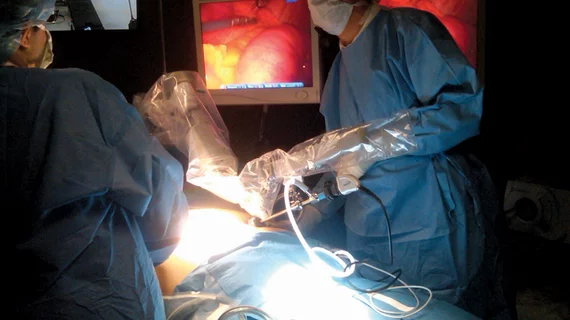RYGB associated with most weight loss among bariatric procedures
Roux-en-Y gastric bypass (RYGB) is linked to greater weight loss compared to two other bariatric procedures but also the highest risk of adverse events in the short term, researchers reported in the Annals of Internal Medicine.
The retrospective analysis included data from more than 65,000 patients who underwent weight-loss procedures from 2005 through September 2015—including 32,208 RYGB patients, 29,693 sleeve gastrectomy patients and 3,192 who received adjustable gastric banding (AGB).
RYGB patients lost 31.2 percent of their total body weight at one year and maintained much of that weight loss, with a 25.5 percent reduction five years post-operation. Sleeve gastrectomy patients were next in terms of weight loss, with 25.2 percent of total body weight lost at one year and 18.8 percent at five years. Total weight loss for AGB was 13.7 percent and 11.7 percent at one and five years, respectively.
Patient data was pulled from 41 health systems participating in the National Patient-Centered Clinical Research Network.
“Bariatric surgical outcomes can vary widely across surgical centers, but the data presented here are probably more broadly representative of the typical experience of patients having bariatric surgery in most major surgical centers in the United States,” wrote lead author David Arterburn, MD, MPH, with Kaiser Permanente Washington Health Research Institute in Seattle, and colleagues. “The magnitude of the weight loss differences we observed will likely be meaningful to patients and providers as they consider treatment options for severe obesity.”
The authors said previous data was relatively limited in comparing RYGB and sleeve gastrectomy, even though SG has now overtaken the gastric bypass procedure in procedural volumes both in the U.S. and worldwide. According to the researchers, there are only five U.S. studies with at least five years of follow-up that compare SG and RYGB—and those studies combined encompass fewer than 900 patients for each procedure, necessitating additional long-term research.
“There is no consensus in the medical community about the clinical utility of these procedures for weight loss, leading to unwarranted variation in insurance coverage and use of these procedures in the United States,” Arterburn et al. wrote.
In this analysis, RYGB was associated with the highest rate of 30-day major adverse events, at 5 percent. Event rates were 2.9 percent and 2.6 percent for AGB and sleeve gastrectomy, respectively.
The difference between RYBG and sleeve gastrectomy was largely driven by the need for re-intervention (4.1 percent in RYBG; 1.9 percent in SG). Deaths occurred in 0.2 percent and 0.1 percent of patients undergoing RYBG and sleeve gastrectomy, respectively, and the rates of venous thromboembolism (0.7 percent versus 0.6 percent) within 30 days were also similar.
“Health care providers, patients, and policymakers can use these data to inform treatment and insurance coverage decisions,” Arterburn and coauthors wrote. “Not every patient with severe obesity will be interested in bariatric surgery, but all providers should incorporate a shared decision-making discussion of its potential role into their clinical practice.”
Racial minorities, diabetics, older patients and those with a preoperative body mass index of less than 50 lost less weight with both RYGB and SG than individuals not meeting those criteria, but the researchers noted those differences were “clinically small and generally less than 3%.”
One limitation of the study was that weight data weren’t systematically and prospectively collected, so patient weights at specific timepoints were estimated using statistical modeling.
The authors of a related editorial pointed out the study’s five-year follow-up and large sample size were strengths, providing a basis “for reliable estimation of treatment response by subgroup characteristics.”
But they also highlighted other shortcomings, including the lack of follow-up with complications beyond 30 days, and the fact that between 14 and 45 percent of patients in the specific procedural groups were lost to follow-up at five years.
“It is possible, if not likely, that patients with suboptimal weight loss are less likely to return to their surgical center because they are embarrassed or ashamed, believing they are at fault for their ‘failure,’” wrote Nancy Puzziferri, MD, MSCS, and Bruce M. Wolfe, MD. “Thus, the potential remains for systematic bias with regard to long-term weight loss.”
Even so, the editorialists called Arterburn et al.’s study an “important report” with “potential actionable information.” More work could further clarify the utility of bariatric surgery.
“The details of cost–benefit ratios for bariatric surgery and time to recover investment have not been fully studied and reported,” they wrote. “Once subsequent costs—such as medications; additional procedures; and number of outpatient, inpatient, and emergency encounters—are accurately and broadly quantified, the true value of bariatric surgery will emerge.”

